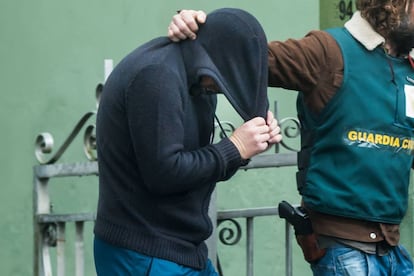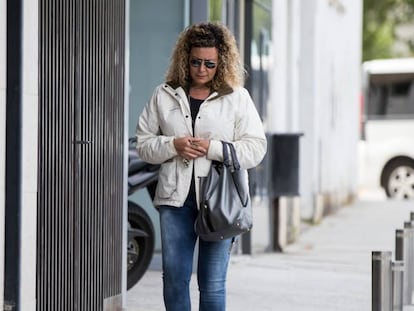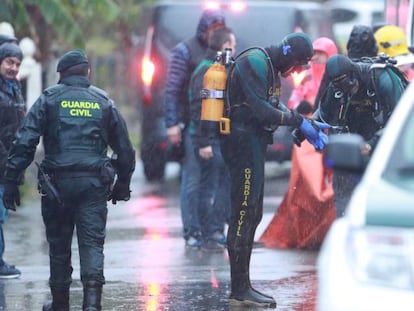The toxic ripple effect of Diana Quer’s murder
Relatives of the alleged killer are being relentlessly harassed on social media

On August 22, 2016, the Spanish Civil Guard issued an alert over the disappearance of an 18-year-old woman in the Galician village of A Pobra do Caramiñal. On January 3, 2018, a woman logged onto Facebook, saw a photograph of a 12-year-old girl, and wished her dead. This is a story about hate and innocent girls. About physical and civil death. About a murderer and a murder.
Diana was not the most rebellious of the two Quer sisters. At 18 and 14, they were both dealing with the emotional turmoil that comes with adolescence, amplified by their parents’ divorce. Diana went missing in an idyllic spot, the seaside promenade of A Pobra, the village where she used to spend her summers. Passersby can still see what’s left of Boomerang, a former nightclub that was once a cult destination in the 1980s, so close to the sea that one could leave the premises, go for a dip and come back.
Diana Quer vanished into thin air near here, at a spot where an Italian restaurant now stands. It happened during the local fiestas, on a night of outdoor celebrations on a well-lit walkway next to the beach; Diana was wearing pink shorts, a white tee, a sweatshirt and sneakers. Her house in Xobre, Monte Curota, has commanding views of town. When the sun rose and her mother saw that Diana was not in her bedroom, she jumped into her car and drove to the Civil Guard station.
Officers came home with her to start a small investigation into what looked like it might simply be a case of extended partying. But alarms started to go off immediately: she had never done such a thing, and she would not have been this late without warning someone about it. True, she had left home a couple of times before, but always after a big argument, slamming the door behind her. It was not the case this time.
Twenty-four hours later, the media timidly began echoing the case: “A young Madrileña,” “an 18-year-old girl,” “a young woman who is missing.” It is impossible to know what was going through the mind of José Enrique Abuín, also known by his nicknames of El Chicle or Chikilín, at this time. A 41-year-old husband and father of one, Abuín lived in the nearby town of Taragoña (Rianxo), held odd jobs, many of them illegal, and went to his parents’ place for lunch every day. He loved running and had completed the marathon season in June 2016 with a team that included his own daughter.
If I already felt disgusted by him before, even more so now Nephew of Abuín
In early July, he attended the local fiestas of San Antonio de Catoira, his wife Rosario Rodríguez’s home town, where they both spent time with one of Rosario’s sisters and the latter’s husband. Later, this couple provided Abuín with the alibi he used to justify his whereabouts on the night that Diana Quer went missing. (He had told his in-laws that he had nothing to do with it, but would ultimately threaten them).
On Saturday, July 23, Abuín, his wife and his daughter spent a day in Padrón and took pictures on the drawbridge of O Xirimbao. In mid-August, he covered his own house inTaragoña with green scaffolding in order to repaint it. On Sunday, August 21 he told his wife at around 10pm that he was going out to steal some diesel. Between 2am and 3am, he forced an 18-year-old woman named Diana Quer into his car. According to his own spontaneous confession at the time that he led investigators to her body – a statement that carries no legal weight – he strangled her after being unable to rape her.
The different levels of destruction that come with murder are all on a massive scale in this case. All that’s left in Rianxo is scorched earth and a funereal silence following two weeks that residents will never forget. It is in the midst of this silence that the Abuín family is trying to pick up the pieces of their lives. The graffiti on their house walls (“murderers,” “accomplice,” “Chikilín you’re dead”) are only the tip of the iceberg, compared with the relentless harassment on social media. The comments have even reached his 12-year-old daughter, whom one woman wished dead so that Abuín might pay the same price that Diana Quer’s family is paying. A man left the following message under the daughter’s photograph: “Daughter of a murderer.”
The Abuín family members are trying to pick up the pieces of their lives
These comments are replied to by other users asking for the family to be left alone. But despite the entreaties, people have shared pictures of the child, her mother, her uncles and aunts. Regarding Abuín’s 19-year-old nephew, a woman wrote: “The same face and the same teeth.” Another user wrote: “You all share the same blood and this one looks like the murderer.” The young man in question had a bad relationship with his uncle, and has asked for the death penalty – which does not exist in Spain – for rapists and murderers: “If I already felt disgusted by him before, even more so now.”
Dozens of comments have been piling up in the Facebook accounts of anyone with some connection to El Chicle, while his own accumulates thousands. Someone with access to his account has deleted threads of over 2,000 messages that contained all kinds of expressions of hate, especially homophobic ones in connection with his stay in prison.
The abandoned factory where Diana Quer’s body turned up, inside a freshwater well, has become an improvised shrine to her memory. There are fresh flowers and messages left by the same people who searched for her tirelessly in late August 2016. The spot is located 200 meters from the home of Abuín's parents. Despite knowing that he was a chief suspect in the case and under surveillance, Abuín recently assaulted another woman who looked like Diana using a similar technique.
Nothing is closed in connection with José Enrique Abuín: everything remains under investigation. The consequences of the murder are already running along two parallel lines: on one side, the judiciary’s work, on the other, his family’s pain. Outside of these spotlights, the toxicity of the crime rots everything that comes near.
English version by Susana Urra.
Tu suscripción se está usando en otro dispositivo
¿Quieres añadir otro usuario a tu suscripción?
Si continúas leyendo en este dispositivo, no se podrá leer en el otro.
FlechaTu suscripción se está usando en otro dispositivo y solo puedes acceder a EL PAÍS desde un dispositivo a la vez.
Si quieres compartir tu cuenta, cambia tu suscripción a la modalidad Premium, así podrás añadir otro usuario. Cada uno accederá con su propia cuenta de email, lo que os permitirá personalizar vuestra experiencia en EL PAÍS.
¿Tienes una suscripción de empresa? Accede aquí para contratar más cuentas.
En el caso de no saber quién está usando tu cuenta, te recomendamos cambiar tu contraseña aquí.
Si decides continuar compartiendo tu cuenta, este mensaje se mostrará en tu dispositivo y en el de la otra persona que está usando tu cuenta de forma indefinida, afectando a tu experiencia de lectura. Puedes consultar aquí los términos y condiciones de la suscripción digital.
More information
Archived In
Últimas noticias
Most viewed
- Reinhard Genzel, Nobel laureate in physics: ‘One-minute videos will never give you the truth’
- Pablo Escobar’s hippos: A serious environmental problem, 40 years on
- Charles Dubouloz, mountaineering star, retires at 36 with a farewell tour inspired by Walter Bonatti
- Why we lost the habit of sleeping in two segments and how that changed our sense of time
- The Florida Keys tourist paradise is besieged by immigration agents: ‘We’ve never seen anything like this’











































